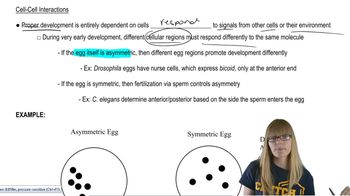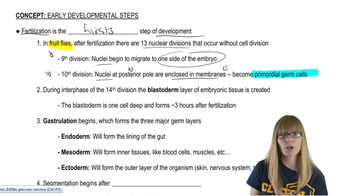Table of contents
- 1. Introduction to Genetics51m
- 2. Mendel's Laws of Inheritance3h 37m
- 3. Extensions to Mendelian Inheritance2h 41m
- 4. Genetic Mapping and Linkage2h 28m
- 5. Genetics of Bacteria and Viruses1h 21m
- 6. Chromosomal Variation1h 48m
- 7. DNA and Chromosome Structure56m
- 8. DNA Replication1h 10m
- 9. Mitosis and Meiosis1h 34m
- 10. Transcription1h 0m
- 11. Translation58m
- 12. Gene Regulation in Prokaryotes1h 19m
- 13. Gene Regulation in Eukaryotes44m
- 14. Genetic Control of Development44m
- 15. Genomes and Genomics1h 50m
- 16. Transposable Elements47m
- 17. Mutation, Repair, and Recombination1h 6m
- 18. Molecular Genetic Tools19m
- 19. Cancer Genetics29m
- 20. Quantitative Genetics1h 26m
- 21. Population Genetics50m
- 22. Evolutionary Genetics29m
14. Genetic Control of Development
Early Developmental Steps
Problem 1b
Textbook Question
In this chapter, we have focused on large-scale as well as the inter- and intracellular events that take place during embryogenesis and the formation of adult structures. In particular, we discussed how the adult body plan is laid down by a cascade of gene expression, and the role of cell–cell communication in development. Based on your knowledge of these topics, answer several fundamental questions:
How did we discover that selector genes specify which adult structures will be formed by body segments?
 Verified step by step guidance
Verified step by step guidance1
Understand the concept of selector genes: Selector genes are crucial in determining the identity of body segments during development. They are a part of the genetic toolkit that specifies the formation of adult structures.
Explore the historical context: Research the experiments and discoveries that led to the identification of selector genes. This includes studying model organisms like Drosophila melanogaster (fruit fly), which has been instrumental in developmental genetics.
Examine key experiments: Look into the genetic and molecular experiments that demonstrated the role of selector genes. For example, the discovery of homeotic genes, which are a type of selector gene, was pivotal in understanding segment specification.
Analyze gene expression patterns: Investigate how the expression patterns of selector genes correlate with the development of specific body segments. Techniques such as in situ hybridization and reporter gene assays have been used to visualize these patterns.
Review the role of cell-cell communication: Consider how intercellular signaling pathways interact with selector genes to refine and implement the developmental blueprint laid out by these genes.
Recommended similar problem, with video answer:
 Verified Solution
Verified SolutionThis video solution was recommended by our tutors as helpful for the problem above
Video duration:
3mPlay a video:
Was this helpful?
Key Concepts
Here are the essential concepts you must grasp in order to answer the question correctly.
Selector Genes
Selector genes are a group of regulatory genes that determine the identity of body segments during embryonic development. They function by activating specific developmental pathways that lead to the formation of distinct structures in the adult organism. The discovery of their role was largely facilitated by genetic studies in model organisms, such as Drosophila, where mutations in these genes resulted in the transformation of one body segment into another.
Recommended video:
Guided course

Mapping Genes
Gene Expression Cascade
A gene expression cascade refers to a series of sequential gene activations that lead to the development of specific traits or structures. In embryogenesis, this cascade is crucial for establishing the body plan, as it orchestrates the timing and spatial distribution of gene activity. Understanding this cascade helps explain how complex organisms develop from a single fertilized egg into a fully formed adult.
Recommended video:
Guided course

Penetrance and Expressivity
Cell–Cell Communication
Cell–cell communication is essential for coordinating developmental processes during embryogenesis. It involves signaling molecules that allow cells to communicate their position and developmental status to neighboring cells, influencing their fate. This interaction is vital for ensuring that the correct structures form in the right locations, as it helps integrate the activities of selector genes and the gene expression cascade.
Recommended video:
Guided course

Cell-cell interactions

 3:46m
3:46mWatch next
Master Drosophilia Development with a bite sized video explanation from Kylia Goodner
Start learningRelated Videos
Related Practice


